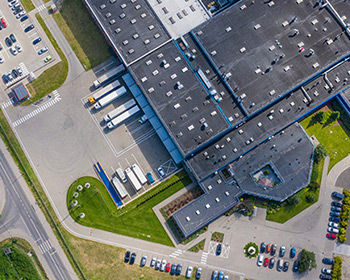Conventional industrial concrete floors have many drawbacks that can affect the plant’s productivity, safety and in some case, the pollution of soils.
- They are slow and costly to construct;
- They can be worn away by heavy traffic, such as forklifts and trucks, or heavy loads from stocks;
- They can be subject to abrasions from heavy cargo, and to differential temperature variations;
- They also suffer from frequent joints and comparatively weak reinforcement systems, hence generating a major risk of failure, triggering the need for joints maintenance, and frequent and costly repair operations for both slab and rolling equipment such as trucks and forklifts.
In the end, this leads to unavailability of your asset, with direct impact on productivity!
A post-tensioned slab on grade overcomes these issues, with real value-for-money advantage:
- With very few or no joints at all, it is less prone to cracking or damage;
- Because it is thinner and lighter, its construction cycle is much shorter, saving time and money; post-tensioned slab on grade is also less expensive than most other slab/pavement systems at construction stage;
- The slab will also have a much longer lifespan than a conventional one;
- It offers real performance benefits, as a single continuous space is much more flexible for industrial operations;
- Vehicles enjoy a much smoother ride across the surface, meaning lower maintenance costs and a safer working environment;
- It is fully adapted to rapid logistics equipment, such as fast-moving robots, and also high-stacking!
VSL can provide you with a mega solid slab, with almost no maintenance, able to support super heavy loads and any temperatures virials and to adapt to robots, and managing pollution.
An industrial floor slab on grade should be durable, free of excessive cracking, suitably flat and able to withstand traffic loads. Prior to any slab on grade construction project, VSL will study different issues to set up the best construction scheme:
- The environmental and site conditions;
- The traffic requirements;
- The loads on the slab;
- Slab thickness and reinforcement requirements;
- Joint location and spacing;
- Method of slab construction.
VSL’s slab on grade system provides a high-quality solution for concrete slabs that are placed directly on the ground and offers great value for money. Our objective is to:
- Limit the number of joints while keeping the structure within allowable tensile stresses;
- Make use of post-tensioning technology to prevent the risk of failures, resist tensile stresses and provide the highest loading capacity;
- Optimize the overall cost of the facility thanks to an optimum combination of post-tensioning, slab thickness and concrete tensile strength;
- Lower long-term maintenance and repair costs, capitalizing on the inherent crack-inhibition properties of prestressing slab.
The advantages of VSL slab on grade system are numerous:
- It uses up to 30 % less concrete and therefore, it is a very effective solution to reduce the carbon footprint of a structure;
- It offers a wide freedom of choice for coatings and finishing, depending on the appearance and material characteristics: polished mirror finishing, half polished finishing, quartz finishing, and more;
- It relies on VSL robust, worldwide proven and ever evolving post-tensioning technologies;
- It has been used successfully worldwide in various types of logistics and manufacturing facilities, workshops and other structures and has been recognized through a number of Awards.
Last but not least, when combined with ground improvement, VSL slab on grade can provide cost-effective and very resilient foundations for industrial facilities.
VSL can provide either specific missions, or a design, supply and build package including:
- Ground analysis and preliminary design
- Final design
- Subgrade preparation
- Supply and placing of the sand base and plastic layer
- Supply and installation of the normal reinforcement associated with the post-tensioned slab
- Supply and placement of the post-tensioning components and carrying out the post-tensioning works
- Supply, placing, finishing and curing of concrete
- Final coating if required








